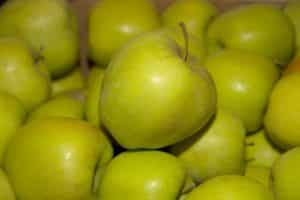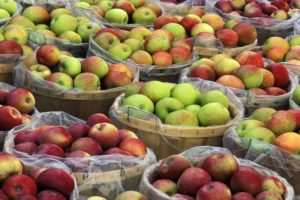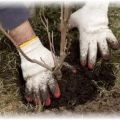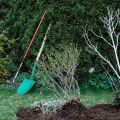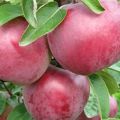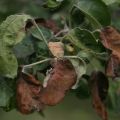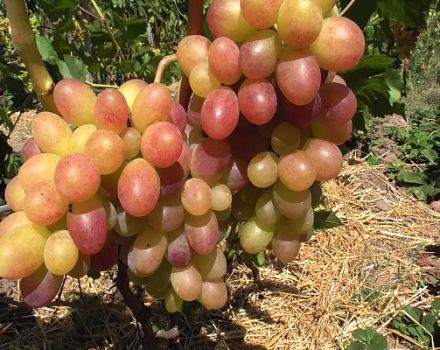The reasons for the appearance of powdery mildew on an apple tree, how to fight and what to do for treatment
The most common disease that significantly reduces the yield of fruit trees is powdery mildew. Heat-loving plants grown in a temperate climate are at risk, but with an uncharacteristic temperature regime for the region and increased average annual humidity, powdery mildew appears on apple trees, the most traditional fruit tree of the temperate climatic zone.
Content
- 1 What is this disease
- 2 Who is the causative agent
- 3 Distribution area
- 4 The main causes and factors of the development of the disease
- 5 Signs of tree infection
- 6 What is dangerous for a tree
- 7 Preparations for powdery mildew on an apple tree
- 8 Control measures
- 9 Prevention
- 10 How to fertilize an apple tree in the fall against a disease?
- 11 Powdery Mildew Resistant Varieties
What is this disease
Fungal disease of garden fruit trees, shrubs, root crops has several names, the most common are:
- linen;
- powdery mildew;
- ashtray.
What looks like a white bloom on leaves, flowers, fruits, is the mycelium of microscopic fungi that multiply exponentially, every day a colony of pathogenic fungi captures more and more surface areas of leaves, bark and other external parts of the plant.
Spores are easily carried by wind and insects, which, if one tree on the site becomes ill, threatens to develop into a real epidemic of the entire garden.
A fungal disease develops on the bark, leaves and fruits. If at an early stage of defeat in the fight against this scourge it is possible to save most of the harvest, then with an apple tree disease at the stage of fruit ripening, losses can amount to up to 80% of the harvest.
Who is the causative agent
Powdery mildew is caused by marsupials of the order Erysiphaceae (erysipheans), there are more than 700 species in it, causing powdery plaque - 100. This class also includes Erysiphe, which causes Oidium.

Powdery mildew fungi are pyrenomycetes, each of the agricultural plants is susceptible to damage by representatives of a certain species:
- Blumeria graminis is a parasite on cereals.
- Trifolia precipitates legumes.
- Sphaerotheca mors-uvae damages gooseberries and black currants.
- Betae threatens sugar beet yields.
- Cichoracearum spoils potatoes, tobacco, pumpkins.
- Sphaerotheca settles on roses and other ornamental shrubs.
- Uncinula necator prefers grapes.
- Podosphaera is a common threat to fruit trees, including apple trees.
The peculiarity of the parasitic mealy fungi is that their colony lives only until the plant is alive. Having attached to the surface of a leaf or stem in early summer, the fungi will die with it.

Parasitic activity of fungi
The mycelium of the fungi causing the disease is superficial with appressoria (suction cups). To fix on the leaves, mushrooms grow into plant cells with short hyphae with haustoria. During the growing season, fungi plants reproduce by conidia (asexual stage); in a tropical climate, it may be the only one. Conidia are arranged in islets or chains.
In a temperate continental climate, fungi have 2 stages of development - asexual and sexual (marsupial).
Like all mushrooms, erysipheans have fruiting bodies - cleistothecia. On a spherical mushroom with a concave tip, there are appendages in the form of simple or branched outgrowths. Each of them contains from 1 to 22 asci, which in turn are a repository for 2-8 ascospores. With such fertility, the mycelium will conquer the entire fruit tree in a matter of days, if preventive and therapeutic measures are not taken in time.
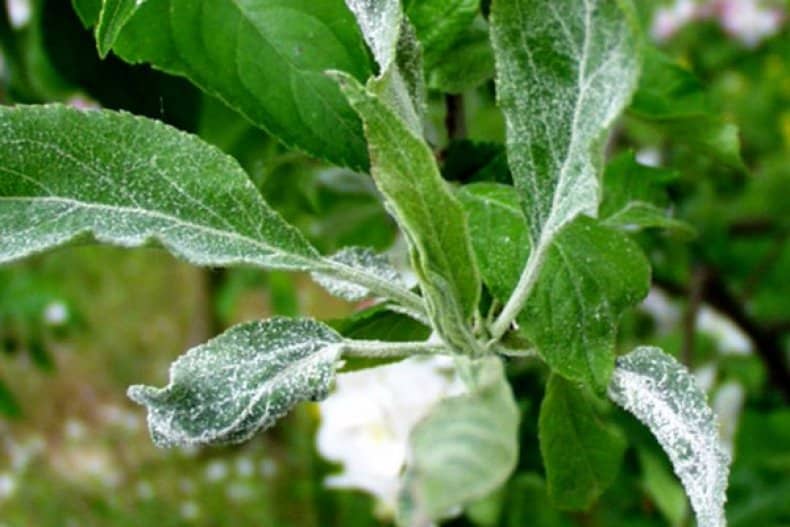
Distribution area
The mycelium of marsupial fungi that cause leucorrhoea does not tolerate severe frosts; the mycelium can overwinter provided that it is located deep in the bark of a tree affected by the previous season. Due to the harsh climatic conditions - severe frosts, short dry hot summer, fruit trees are least often affected by powdery mildew grown in Siberia and other northern regions.
Almost powdery mildew on fruit trees can be found anywhere in the world, the largest areas of damage are observed in countries with a temperate continental climate.
The higher the humidity of the air and soil, the fewer sunny days in summer, the higher the risk. The most favorable conditions for the spread of pathogenic fungi are the Baltic States, the north-western regions of the Leningrad Region and the Moscow Region. A little lower, powdery mildew causes harm to the crops of the Krasnodar Territory, Kazakhstan, Uzbekistan, Ukraine, Belarus, Moldova.
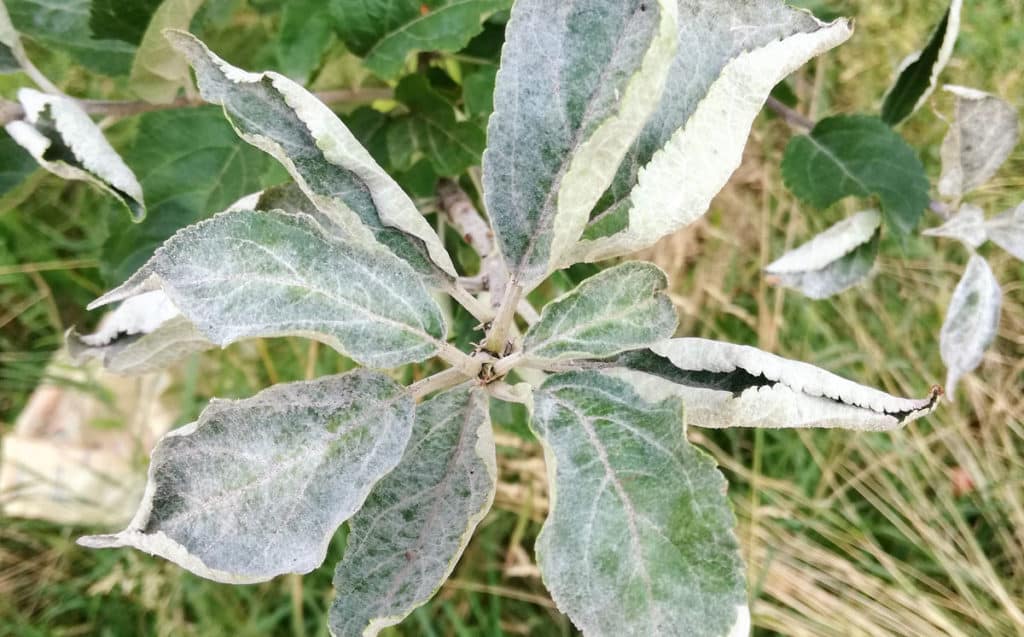
The main causes and factors of the development of the disease
Between plants, the disease spreads conidially, methodically capturing new areas on the leaves and bark of an infected tree and adjacent drupe, berry, fruit trees and shrubs.
A favorable environment for mycelium is created by:
- soils with poor water conductivity;
- lack of sunlight at high air temperatures;
- mild winters with thaws;
- warm, swift spring after a snowy winter.
Under such natural conditions, the mycelium will develop rapidly. During the maturation stage of the spores, wind and heavy rain will favor reproduction and disease transmission.
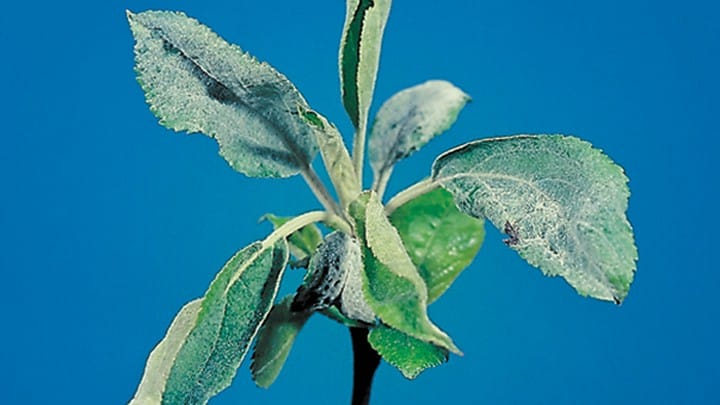
Signs of tree infection
A white translucent bloom formed on the shoots and leaves at the stage of the appearance of the first leaves is a sign of the manifestation of the disease. At the same time, buds that have not yet blossomed begin to wither, deform, brown, wither and fall off.
The lesions only initially look white, the development of the disease is evidenced by a denser silvery plaque, it seems as such due to the formation of cleistotecia.
At first, these are rare black spots, at a later stage, the fungal coating acquires a brown tint. White bloom on fruits is a short-term phenomenon. Apples affected by the fungus acquire brown lignified spots and veins on the skin.
What is dangerous for a tree
Despite the fact that plaque can be easily erased from leaves, shoots and even bark, the disease has already affected the epidermal cells of the plant - it has grown in them. The hyphae and haustoria remaining inside continue to parasitize, due to this, after a while the spot becomes gray, brown or purple. The mycelium takes all vital juices from its donor - the leaves dry out, the ovaries do not have time to form, and the existing fruits fall prematurely or lose their presentation, do not gain the standard weight for the variety.

The mycelium of fungi that cause powdery mildew on apple trees most often does not survive wintering, but under favorable breeding conditions, it can destroy an unstable young seedling due to the compaction of the mycelium. Adult apple trees with chronic dew cease to bear fruit long before the end of the characteristic period for the variety.
For your information: the incubation period is 4-9 days.
Preparations for powdery mildew on an apple tree
Colloidal sulfur is a universal remedy for fungal infections and insect pests of fruit trees. Trees are sprayed with a 2% solution during the budding period, until the flower bowl opens. At the end of flowering, for preventive purposes, treatment with a 1% composition is performed.
When treating with a universal fungicide - Bordeaux mixture, a 3% solution is taken for the first spraying, a 1% solution is required for the second. For effective protection of apple trees from re-infection, a penconazole drug "Topaz" is recommended, it penetrates deep into the tissues of the tree and fights the pathogen from the inside, and not only with the superficial manifestations of the disease.

Just like Topaz, gardeners are in demand:
- granulated urea;
- "Impact";
- "Cumulus";
- Tebuconazole;
- Topsin;
- Fitosporin.
In the absence of specialized chemicals at hand, there are several options than to process the apple tree when the first signs of ash are found.
Folk remedies
Three simple recipes have long been used effectively by amateur gardeners. Recommended proportions for 10 liters of water:
- 50 g of soda ash with 40 g of grated laundry soap.
- 3 g of potassium permanganate (potassium permanganate);
- "Khom" - copper oxychloride, 40 g.
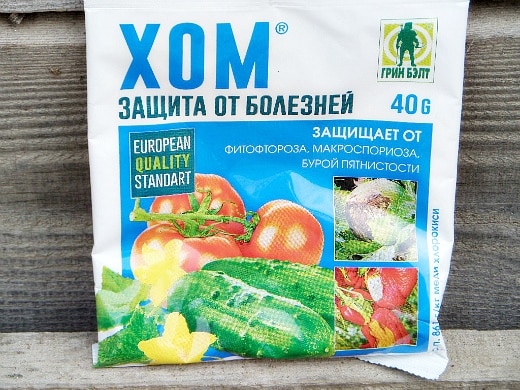
These funds, in combination with dressings, give a good preventive effect; in case of a disease, such spraying gives the gardener a delay of 3-4 days. Severe lesions must be treated with specialized remedies. Sometimes it makes sense to sacrifice one season's harvest to preserve the tree.
Control measures
In addition to three times spraying with fungicides per season, it is necessary to strictly dose the fertilizing. Nitrogen fertilizers increase the ability to develop not only agricultural crops, but also fungi parasitizing them - if the recommended norms of nitrogen fertilizers are exceeded, mycelium will spread especially quickly. Potash and phosphorus fertilizers reduce its vital activity.
Prevention at the stage of the initial growing season is important, but how to deal with powdery mildew during fruit ripening? Folk remedies do not affect the quality of the fruit; with an increased risk of infection of the plant with powdery mildew, it is recommended to spray apple trees with potassium permanganate or a solution of soda with laundry soap once every 10-14 days.
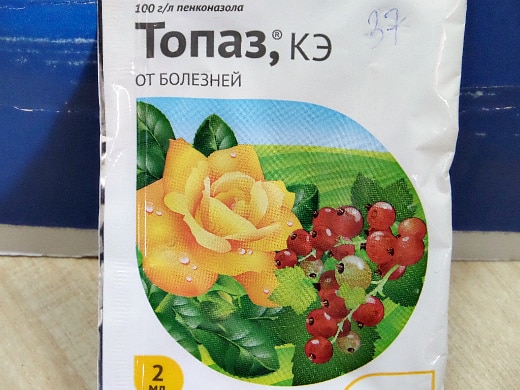
If the tree is infected, manifestations of the disease not only on the leaves, but also on the branches, trunk, then you cannot do without Topaz or a fungicide similar to it in action. The first 2 sprays are carried out at intervals of 3-4 days. Further, until the fruit ripens, it is necessary to carry out prevention.
Treatment of an adult tree
The processing of a tall apple tree with a dense crown is difficult, spraying is carried out not only on the surface of the leaves, it is necessary to process the branches, the trunk, the lower part of the leaves. This will require an assistant pumping the solution and personal protective equipment - glasses, a suit that maximally protects parts of the body.
What to do with an apple tree when a whole branch of an adult plant is affected? It is easier to remove and burn it, in such a case a stepladder, pruner, hacksaw, garden pitch should always be at hand. To prevent the development of powdery mildew after winter from mycelium overwintered in the soil:
- Mulch is removed from under the tree.
- In spring and autumn, the trunk is whitewashed.
- No last year's leaves and fruits should be on the site.

The manifestations of the disease on apples do not affect the palatability, but the apples will be less juicy. If pathogens can be overcome with the help of folk remedies or gentle dosages of chemicals, then the crop can be used for food.
Attention! You can find out after what treatments apples are suitable for eating on the packaging of professional products. The manufacturer's instructions will be relevant if the recommended proportions are strictly observed during use.
How to save young seedlings
To protect apple tree seedlings during the planting season, they are soaked for a day in a weak solution of potassium permanganate (potassium permanganate). The water should take on a light pinkish tint, a strong solution can cause burns, the plant will hurt. To improve the survival rate of the seedling, it is better to use growth stimulants, and it is better to refuse nitrogenous fertilizing, because in the first season the apple tree (on any rootstock) is not expected to be harvested.
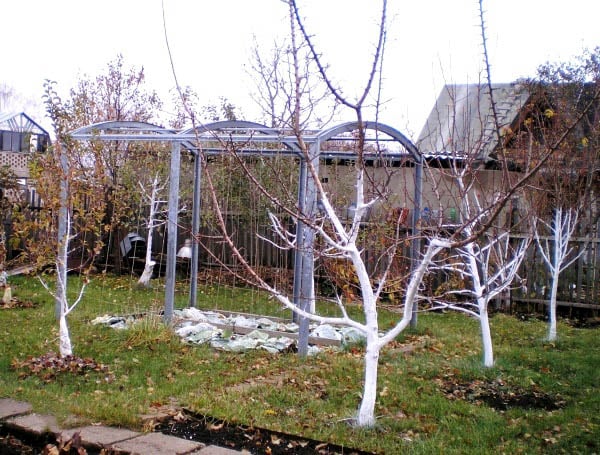
Prevention
When sampling a site for planting, avoid proximity to plants affected by the fungus, protect it from the leeward side, but do not plant it in the shade of a house or a monolithic fence. Be sure to adhere to the recommended intervals for fruit trees.
Thinning of the crown, removal of affected and old (non-fruiting) branches, cleaning of fallen leaves and fruits, mulching and whitewashing, the introduction of potash and phosphorus fertilizers is mandatory.
How to fertilize an apple tree in the fall against a disease?
1-1.5% sodium phosphate solution strengthens the plant, helps to establish the formation of strong, healthy buds, enhances the plant's immunity to diseases.

Seasonal processing
Phosphate spraying of apple trees and other fruit trees is carried out after harvest, but until the leaves have fallen off and turned yellow. The solution is absorbed through the leaf plates, thereby protecting the plant from infection with powdery mildew and other fungal diseases after winter.
On apple varieties of late maturity, the leaves fall off before the tree is harvested; in this case, phosphate must be applied through the soil with the last watering of the season. Thinning of the thickening crown of the tree prevents the rapid spread of the disease, whitewashing the trunk makes it difficult for hyphae and haustoria to penetrate into the bark of the plant.
Powdery Mildew Resistant Varieties
For the resistance of the apple tree to certain strains of diseases in plants, as in all living organisms, the gene is responsible, which is the strongest in apple trees of breeding varieties:
- Amulet;
- Argo;
- Gloucester;
- Duet;
- Marshmallow;
- Summer gold;
- Carmen;
- Red poppy;
- Red amber;
- Kupava;
- Linda;
- Mutsu;
- Orion;
- Palette;
- Prestige;
- Dawn;
- Redfrey;
- Fontanelle;
- Union;
- Talida;
- Mascot;
- Fortune;
- Fairy.
This is not a complete list of powdery mildew resistant apple trees. For each of the regions, other varieties with high resistance rates can be found in local nurseries. When choosing an apple variety, it must be remembered that the immunity to one disease in an apple tree can be compensated for by a weak resistance to other types of pathogens.
